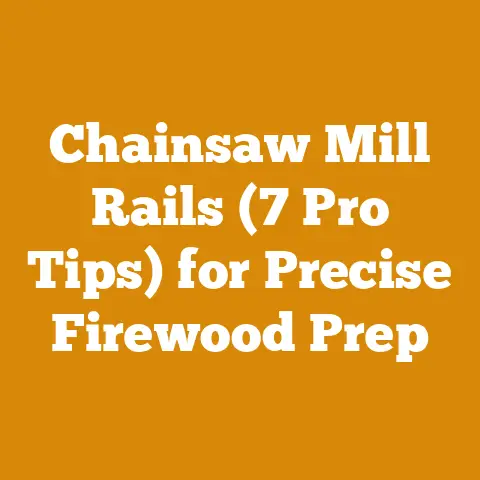Beech Tree Firewood Drying & Burn Quality (Pro Tips Revealed)
Did you know that the seemingly humble beech tree holds secrets to both frustrating and fantastic firewood? I’ve spent countless hours wrestling with beech, and let me tell you, it’s a wood that demands respect. In this article, I’m going to share everything I’ve learned about beech firewood – from its quirks and challenges to its surprising burn qualities and the pro tips that will make your wood-burning experience a whole lot smoother.
Understanding the Allure and Annoyance of Beech Firewood
Beech. The very name can elicit groans from seasoned woodcutters or gleeful anticipation from those in the know. Why the mixed reactions? Beech is a dense hardwood, promising long burn times and significant heat output. But it’s also notorious for being slow to season and prone to rot if not handled correctly. Understanding these nuances is key to unlocking beech’s potential as premium firewood.
Beech: A Profile in Wood
To truly appreciate beech, let’s dive into its properties. Beech ( Fagus grandifolia in North America, Fagus sylvatica in Europe) is a deciduous tree known for its smooth, gray bark and distinctive torpedo-shaped buds. The wood itself is close-grained, hard, and heavy, typically a light tan color.
- Density: Beech boasts a density of around 45 lbs per cubic foot when dry. This high density translates directly into more energy packed into each log.
- Heat Value: Expect around 27 million BTUs (British Thermal Units) per cord of seasoned beech. This puts it on par with oak and maple, making it a top-tier choice for heating.
- Moisture Content: Freshly cut beech can have a moisture content exceeding 60%. This is where the challenge begins. Properly seasoned firewood should have a moisture content below 20%.
- Rot Resistance: Beech is considered non-durable. This means it’s highly susceptible to decay if left exposed to moisture and the elements. This is a critical point that will dictate your seasoning strategy.
- Splitting: Beech can be stringy and challenging to split, especially if it has knots or is allowed to dry too much before splitting.
Personal Anecdote: My First Encounter with Beech
I’ll never forget the first time I tackled a large beech tree that had come down in a storm. I envisioned myself with a winter’s worth of premium firewood. Reality hit hard. The wood was incredibly heavy, and splitting it was like wrestling an octopus. I quickly learned that brute force alone wouldn’t cut it (pun intended!). That experience spurred me to research the best techniques for handling beech, which I’m eager to share with you.
Logging Tool Selection: Setting Yourself Up for Success
Working with beech requires the right tools. Trying to muscle through with inadequate equipment will only lead to frustration and potential injury.
Chainsaws: Power and Precision
- For Felling: A chainsaw with a bar length appropriate for the diameter of the tree is essential. I prefer a professional-grade saw with a displacement of 50-60cc for felling larger beech trees. Brands like Stihl, Husqvarna, and Echo are reliable choices. Make sure your chain is sharp and well-maintained. A dull chain will make the already difficult task of cutting beech even harder.
- For Bucking: A smaller, lighter chainsaw can be used for bucking the felled tree into manageable lengths. Consider a saw with a 40-50cc displacement.
- Chainsaw Safety: Always wear appropriate safety gear, including a helmet with a face shield, ear protection, chaps, and gloves. Practice proper felling techniques to avoid kickback and other hazards.
Splitting Tools: Manual vs. Hydraulic
- Manual Splitting:
- Maul: A heavy maul (6-8 lbs) is a good starting point for splitting smaller rounds of beech. Look for a maul with a fiberglass handle for durability and shock absorption.
- Splitting Axe: A splitting axe with a wedge-shaped head is designed to separate the wood fibers efficiently.
- Wedges: Steel wedges can be driven into stubborn rounds to help split them. Use multiple wedges if necessary.
- Hydraulic Splitters:
- Tonnage: For beech, I recommend a hydraulic splitter with at least 20 tons of splitting force. This will handle even the toughest rounds with ease.
- Engine: Choose a splitter with a reliable engine. Brands like Honda and Briggs & Stratton are known for their durability.
- Cycle Time: Consider the cycle time of the splitter. A faster cycle time will allow you to process more wood in less time.
- Safety Features: Look for a splitter with safety features like two-handed operation to prevent accidents.
Comparison: Manual vs. Hydraulic
| Feature | Manual Splitting | Hydraulic Splitter |
|---|---|---|
| Effort | High | Low |
| Speed | Slow | Fast |
| Cost | Low | High |
| Wood Type | Suitable for smaller rounds | Handles large, knotty rounds easily |
| Physical Strain | Significant | Minimal |
My Recommendation
For occasional use and smaller quantities of beech, manual splitting tools can suffice. However, if you plan to process significant amounts of beech firewood, investing in a hydraulic splitter is well worth the cost. It will save you time, energy, and reduce the risk of injury.
Firewood Seasoning: The Key to Unlocking Beech’s Potential
Seasoning is the process of drying firewood to reduce its moisture content. This is crucial for efficient burning and minimizing smoke. Beech, with its high moisture content and susceptibility to rot, requires a meticulous approach to seasoning.
Understanding Moisture Content Dynamics
- Green Wood: Freshly cut beech can have a moisture content of 60% or higher. This means that more than half of its weight is water.
- Seasoned Wood: The ideal moisture content for firewood is below 20%. At this level, the wood will burn efficiently and produce minimal smoke.
- The Seasoning Process: As wood dries, moisture evaporates from the cells. This process is influenced by temperature, humidity, and airflow.
Seasoning Techniques: The Stack is Key
- Location: Choose a sunny, well-ventilated location for your woodpile. Avoid damp or shady areas.
- Elevation: Elevate the wood off the ground using pallets, skids, or even a layer of scrap wood. This allows air to circulate underneath the pile and prevents moisture from wicking up from the ground.
- Stacking Method:
- Loose Stacking: Stack the wood loosely to allow for maximum airflow. Avoid tightly packed piles.
- Single Row Stacking: A single row stack exposes more surface area to the sun and wind, promoting faster drying.
- Criss-Cross Stacking: Criss-crossing the ends of the stack creates stability and allows for good airflow.
- Covering: While airflow is essential, protecting the top of the woodpile from rain and snow is also crucial. Use a tarp or roofing material to cover the top of the pile, leaving the sides open for ventilation.
- End Grain Exposure: Stacking firewood with the end grain exposed to the prevailing winds helps accelerate drying.
- The “Igloo” Method: I once experimented with building a circular stack resembling an igloo, leaving a hollow center for increased airflow. While visually appealing, it proved less efficient than traditional methods.
Time is of the Essence
- Seasoning Time: Beech typically requires at least 12-18 months of seasoning to reach the ideal moisture content. In humid climates, it may take even longer.
- Monitoring Moisture Content: Use a moisture meter to monitor the moisture content of the wood. This will help you determine when it’s ready to burn. Insert the probes of the moisture meter into freshly split faces of several pieces of wood from different parts of the pile.
Common Mistakes to Avoid
- Stacking Wood Directly on the Ground: This will trap moisture and promote rot.
- Tightly Packing the Woodpile: This will restrict airflow and slow down the drying process.
- Failing to Cover the Woodpile: Rain and snow will re-wet the wood, prolonging the seasoning time.
- Burning Wood Before it is Properly Seasoned: This will result in smoky fires, reduced heat output, and increased creosote buildup in your chimney.
Data-Backed Insights
A study by the University of Maine found that properly seasoned firewood can produce up to 50% more heat than green wood. This highlights the importance of patient and thorough seasoning.
Burning Beech: Maximizing Heat Output and Minimizing Smoke
Once your beech firewood is properly seasoned, it’s time to enjoy the fruits of your labor.
Firewood Storage
- Indoor Storage: Bring a small amount of seasoned firewood indoors a few days before you plan to burn it. This will allow it to dry out further and warm up, making it easier to ignite.
- Outdoor Storage: Store the bulk of your seasoned firewood in a dry, sheltered location. A woodshed or covered porch is ideal.
Fire Starting Techniques
- Kindling: Use small, dry pieces of softwood like pine or cedar to start your fire.
- Tinder: Gather dry tinder, such as birch bark, pine needles, or cotton balls soaked in petroleum jelly.
- Top-Down Fire: This method involves placing the kindling and tinder on top of the larger pieces of wood. As the fire burns down, it efficiently ignites the larger pieces.
- Log Cabin Fire: Arrange the firewood in a log cabin pattern, with the kindling and tinder in the center.
Airflow Management
- Damper Control: Adjust the damper on your wood stove or fireplace to control the airflow. More airflow will result in a hotter fire, but it will also burn through the wood more quickly.
- Air Vents: If your wood stove has air vents, experiment with different settings to find the optimal balance between heat output and burn time.
Monitoring Creosote Buildup
- Creosote: Creosote is a flammable substance that can build up in your chimney as a result of burning unseasoned wood or improper burning techniques.
- Chimney Inspection: Inspect your chimney regularly for creosote buildup.
- Chimney Cleaning: Have your chimney professionally cleaned at least once a year, or more frequently if you burn wood regularly.
Burn Quality: A Tale of Two Fires
I once made the mistake of burning beech that I thought was seasoned, but wasn’t quite ready. The fire was smoky, produced little heat, and left a thick layer of creosote in my chimney. The experience taught me the importance of patience and thorough seasoning.
On the other hand, when I burn properly seasoned beech, the difference is remarkable. The fire burns hot and clean, producing a steady, radiant heat that warms the entire house. The long burn times mean I don’t have to constantly tend to the fire.
Project Planning and Execution: A Step-by-Step Guide
Now, let’s put all this knowledge into action with a step-by-step guide to processing and seasoning beech firewood.
Step 1: Tree Selection and Felling
- Identify a Suitable Tree: Choose a beech tree that is mature, healthy, and free of disease.
- Assess the Surroundings: Before felling the tree, assess the surroundings for hazards, such as power lines, buildings, and other trees.
- Plan Your Escape Route: Plan a clear escape route in case the tree falls in an unexpected direction.
- Felling Techniques: Use proper felling techniques to ensure the tree falls safely and predictably.
Step 2: Bucking and Splitting
- Bucking: Buck the felled tree into manageable lengths, typically 16-24 inches.
- Splitting: Split the rounds of wood using a maul, splitting axe, or hydraulic splitter.
- Safety: Wear appropriate safety gear, including gloves, eye protection, and steel-toed boots.
Step 3: Stacking and Seasoning
- Choose a Location: Select a sunny, well-ventilated location for your woodpile.
- Elevate the Wood: Elevate the wood off the ground using pallets or skids.
- Stacking Method: Stack the wood loosely in a single row or criss-cross pattern.
- Cover the Top: Cover the top of the woodpile with a tarp or roofing material.
- Monitor Moisture Content: Use a moisture meter to monitor the moisture content of the wood.
Step 4: Burning and Maintenance
- Fire Starting: Use kindling and tinder to start your fire.
- Airflow Management: Adjust the damper and air vents to control the airflow.
- Chimney Inspection: Inspect your chimney regularly for creosote buildup.
- Chimney Cleaning: Have your chimney professionally cleaned at least once a year.
Case Study: From Tree to Fireplace
I recently helped a friend process a large beech tree that had fallen on his property. We followed the steps outlined above, and after 18 months of seasoning, the wood was ready to burn. My friend was amazed at the heat output and long burn times of the beech firewood. He now considers beech to be his favorite firewood.
Beech vs. Other Hardwoods: A Comparative Analysis
Let’s compare beech to other popular hardwoods commonly used for firewood.
| Wood Type | Density | Heat Value (BTUs/cord) | Seasoning Time | Splitting Difficulty | Rot Resistance |
|---|---|---|---|---|---|
| Beech | High | 27 million | 12-18 months | Difficult | Low |
| Oak | High | 28 million | 12-24 months | Moderate | Moderate |
| Maple | High | 24 million | 6-12 months | Moderate | Moderate |
| Ash | High | 24 million | 6-12 months | Easy | Moderate |
| Birch | Medium | 20 million | 6-12 months | Easy | Low |
Key Takeaways
- Heat Value: Beech is comparable to oak in terms of heat value, making it a top-tier choice for heating.
- Seasoning Time: Beech requires a longer seasoning time than maple, ash, and birch.
- Splitting Difficulty: Beech is more difficult to split than most other hardwoods.
- Rot Resistance: Beech has low rot resistance, requiring careful seasoning and storage.
Cost-Benefit Analysis: Is Beech Worth the Effort?
Processing beech firewood requires more effort than some other hardwoods. Is it worth the extra work?
Factors to Consider
- Availability: Is beech readily available in your area?
- Cost: How does the cost of beech compare to other firewood options?
- Effort: Are you willing to invest the time and effort required to process and season beech firewood?
- Heating Needs: How much firewood do you need to heat your home?
My Conclusion
If beech is readily available and affordable in your area, and you are willing to invest the time and effort to process and season it properly, it can be a worthwhile choice. The high heat value and long burn times make it an excellent option for heating your home. However, if you are looking for a firewood that is easier to process and season, other hardwoods like maple or ash may be a better choice.
Safety Considerations: Protecting Yourself and Others
Working with chainsaws, splitting tools, and heavy wood can be dangerous. Always prioritize safety.
Personal Protective Equipment (PPE)
- Helmet with Face Shield: Protects your head and face from falling debris.
- Ear Protection: Protects your hearing from the noise of chainsaws and other equipment.
- Chaps: Protect your legs from chainsaw cuts.
- Gloves: Protect your hands from cuts, splinters, and vibrations.
- Steel-Toed Boots: Protect your feet from falling wood and other hazards.
Safe Work Practices
- Chainsaw Safety: Follow proper chainsaw safety procedures, including using the correct felling techniques and avoiding kickback.
- Splitting Safety: Use a stable splitting block and keep your hands clear of the splitting area.
- Lifting Safety: Lift heavy wood with your legs, not your back.
- First Aid Kit: Keep a well-stocked first aid kit on hand in case of injury.
Environmental Considerations
- Sustainable Harvesting: Harvest firewood sustainably to ensure the long-term health of the forest.
- Leave No Trace: Clean up your work area and remove any debris.
- Fire Safety: Be aware of fire hazards and take precautions to prevent wildfires.
The Future of Firewood: Trends and Innovations
The world of firewood is constantly evolving. Here are some trends and innovations to watch for.
Wood Pellets and Briquettes
- Wood Pellets: Made from compressed sawdust and other wood waste, wood pellets offer a consistent heat output and are easy to store.
- Wood Briquettes: Similar to wood pellets, wood briquettes are made from compressed wood waste but are larger in size and shape.
Cordwood Construction
- Cordwood Construction: This building technique involves using short pieces of firewood as the primary building material.
Innovations in Wood Stoves
- High-Efficiency Wood Stoves: Modern wood stoves are designed to burn wood more efficiently and produce less smoke.
- EPA Certification: Look for wood stoves that are EPA certified, meaning they meet strict emissions standards.
Final Thoughts: Embrace the Beech, Master the Burn
Beech firewood presents a unique set of challenges and rewards. While it demands patience and meticulous attention to detail, the payoff is a clean-burning, long-lasting heat that’s hard to beat. By understanding its properties, selecting the right tools, mastering the art of seasoning, and prioritizing safety, you can unlock the full potential of this often-underestimated hardwood. So, embrace the beech, learn its secrets, and enjoy the warmth it brings to your home.
Call to Action
Now that you’re armed with the knowledge to tackle beech firewood like a pro, I encourage you to put these tips into action. Try the stacking method I described, invest in a moisture meter, or even consider upgrading to a hydraulic splitter. The rewards of properly seasoned and burned beech are well worth the effort. Happy burning!






